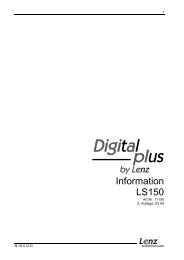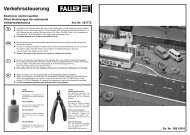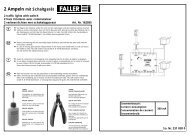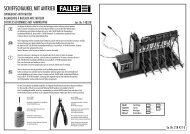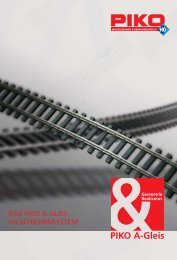INSTRUCTION MANUAL
INSTRUCTION MANUAL
INSTRUCTION MANUAL
Create successful ePaper yourself
Turn your PDF publications into a flip-book with our unique Google optimized e-Paper software.
Decoder MX620 - MX622, MX630 - MX632 Sound Decoder MX640 - MX648 Page 47<br />
Summary of actions when "The sound is too loud"<br />
This subject corresponds to a frequent request of model railroaders, who find ZIMO sound decoders<br />
as OEM equipment in locomotives (Roco, Fleischmann, Hag... since 2010), which often have the<br />
volume set at the factory to the maximum value in order to increase the effect ...<br />
The simplest corrective action to take is of course to lower the overall volume with the help of CV<br />
#266, by reading the value first and subsequently programming a lower value. However, this will of<br />
course influence not only the driving sound but also the function sounds (whistle, horn, brake squeal<br />
etc.), with the result that the latter often become too quiet. Therefore…<br />
Reduce driving sound volume (WITHOUT changing the function sounds) for STEAM engines:<br />
Read out the values in CV’s #275, #276, #283 and #286 (see CV table for detailed information) and<br />
program with lower values. It is often enough to simply modify the CV’s #275 and #276, which are<br />
relevant to cruising speed and it is often only at that speed that too high a volume is annoying.<br />
NOTE (also applies to DIESEL and ELECTRIC engines): The default values shown in the CV table<br />
are most often not used because other values are used within the sound project. That’s why the actual<br />
values should always be read out first, followed by programming a (usually) lower value.<br />
Reduce driving sound volume (WITHOUT changing the function sounds) for DIESEL engines:<br />
Here again, reducing the values in the CV’s #275, #276, #283 and #286 results in a lower volume for<br />
the driving sounds.<br />
In contrast to steam engines the values in these 4 CV’s are the same or very close to each other because<br />
diesel motors don’t react as much to load; as a precaution though, they should still be read<br />
out separately.<br />
Reduce driving sound volume (WITHOUT changing the function sounds) for ELECTRIC engines:<br />
The same CV’s #275, #276, #283 and #286 on electric engines are most often used “only” for the<br />
cooling fan (in some cases they are not used at all), but this may be handled differently from one<br />
sound project to another.<br />
However, the volume of the thyristor sound can be set through the CV's #293, #294, #295 and the<br />
engine sound with #296 (see CV table for detailed descriptions). If necessary read out the current<br />
values of these CV's and replace them with smaller values.




